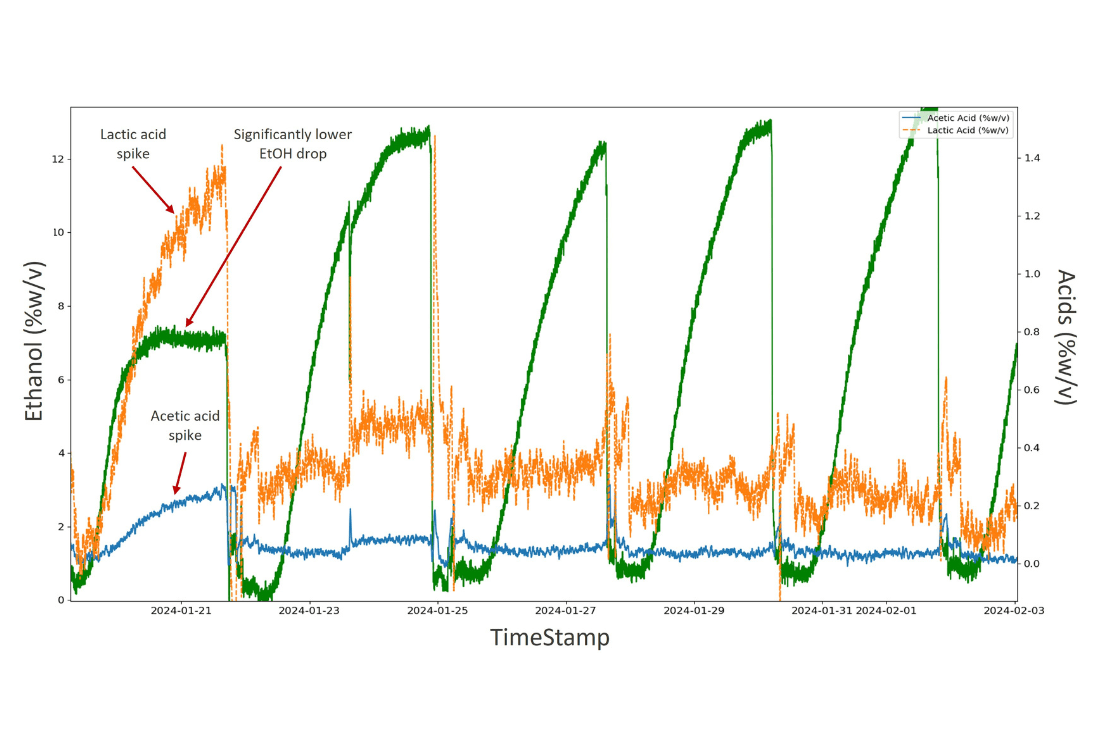
Using The IRmadillo To Detect Lactic And Acetic Acid In Ethanol Fermentations
Abstract
Bacterial contamination in ethanol fermentations can have damaging impacts, in mild cases leading to a drop in ethanol yield, and in more severe cases requiring plant shut down and sterilization resulting in significant loss in revenue. Detecting the signs of these contaminations early allows the operator to limit the impact and avoid significant losses.
Introduction
Lactic acid bacteria are the most common biological contaminants occurring in the fermentation of corn for ethanol production. The growth of these bacteria reduces the amount of sugar available for conversion to ethanol as well as the micro-nutrients required for optimal yeast growth. This results in reduced ethanol production. In addition, the accumulation of bacterial by-products, such as lactic and acetic acid, inhibits yeast growth and may result in "stuck" fermentations that require costly shutdowns. Infections can be halted or minimized using expensive antibiotics and the sooner an infection is identified, less antibiotics are required to counter the infection. Early detection of infections is therefore key to maximizing yields and minimizing antibiotic use.

Spectroscopy As An Analytical Tool
Spectrometers allow continuous and detailed measurement of chemical concentrations in real time. The majority of process spectrometers are based on near infrared light, which is fundamentally less informative than mid infrared light. Conventional mid infrared spectrometers (which often use a Fourier transform and so are referred to as "FTIR spectrometers") have sensitive moving parts and fragile fiber probes making them wholly unsuitable for production environments such as ethanol refineries.
The IRmadillo is a process analyzer that uses FTIR spectroscopy but with static optics, removing the need for moving mirrors or fiber probes, dramatically improving stability, reliability and ruggedness.
Example Use Case - Lactic Acid Detection
This application note presents data from an ethanol refinery in Iowa, measuring the concentration of lactic and acetic acid during fermentation. The plot below (fig 1) shows measurements over time for 5 consecutive fermentations. Fermentation 1 experienced a significant bacterial infection resulting in a spike in lactic acid to 1.4 %w/v (normal is approximately 0.2%w/v) and a spike in acetic acid to 0.3 %w/v (normal is approximately 0 %w/v). Ethanol at drop in fermentation 1 was 7 %w/v, well below the normal of 14 %w/v. We can also see that, over the following 4 fermentations, the levels of lactic acid are elevated, but decreasing, and the ethanol drop value is lower than normal between 12 and 13 %w/v. Only by the 5th fermentation do lactic acid and ethanol drop return to expected levels.
With the IRmadillo installed, the operator can see the rapid increase in lactic and acetic acid levels and is therefore in a position to correct the course of the fermentation, improving yield very significantly in the first fermentation and also in the following fermentations, albeit to a lesser extent.

Figure 1: Concentration trace over five consecutive fermentations, showing the results of a bacterial infection in fermentation 1 with elevated lactic and acetic acid levels and reduced ethanol production. The subsequent 4 fermentations also show evidence of infection with an ongoing negative impact on ethanol yield.
|
Chemical |
Range |
Accuracy |
|
Ethanol (w%/v) |
0 - 15 |
0.25 |
|
Lactic Acid (w%/v) |
0 - 1.5 |
0.056 |
|
Acetic Acid (w%/v) |
0 - 0.35 |
0.015 |
Table 2: Measurement accuracy for species of interest in fermentation during bacterial infection
Conclusion
Bacterial infections, while relatively rare, can be very damaging to process and plant economics when they occur. The ability to manage an infection and minimize its impact on yield relies on catching the infection early while remediation is still possible. The IRmadillo spectrometer has proven to be an accurate early-warning system for bacterial infections, allowing operators to treat the infection early and reduce any loss in yield.

